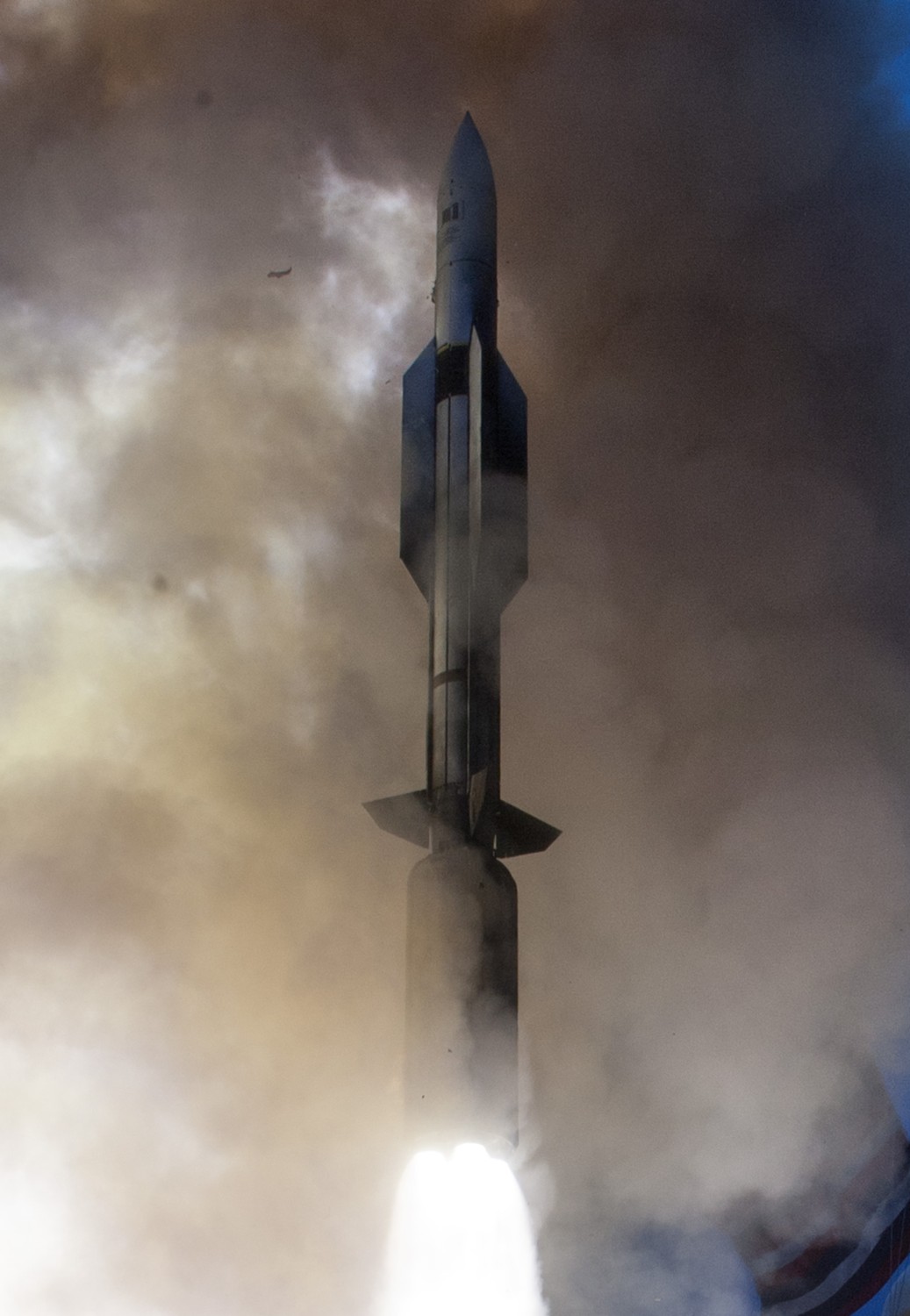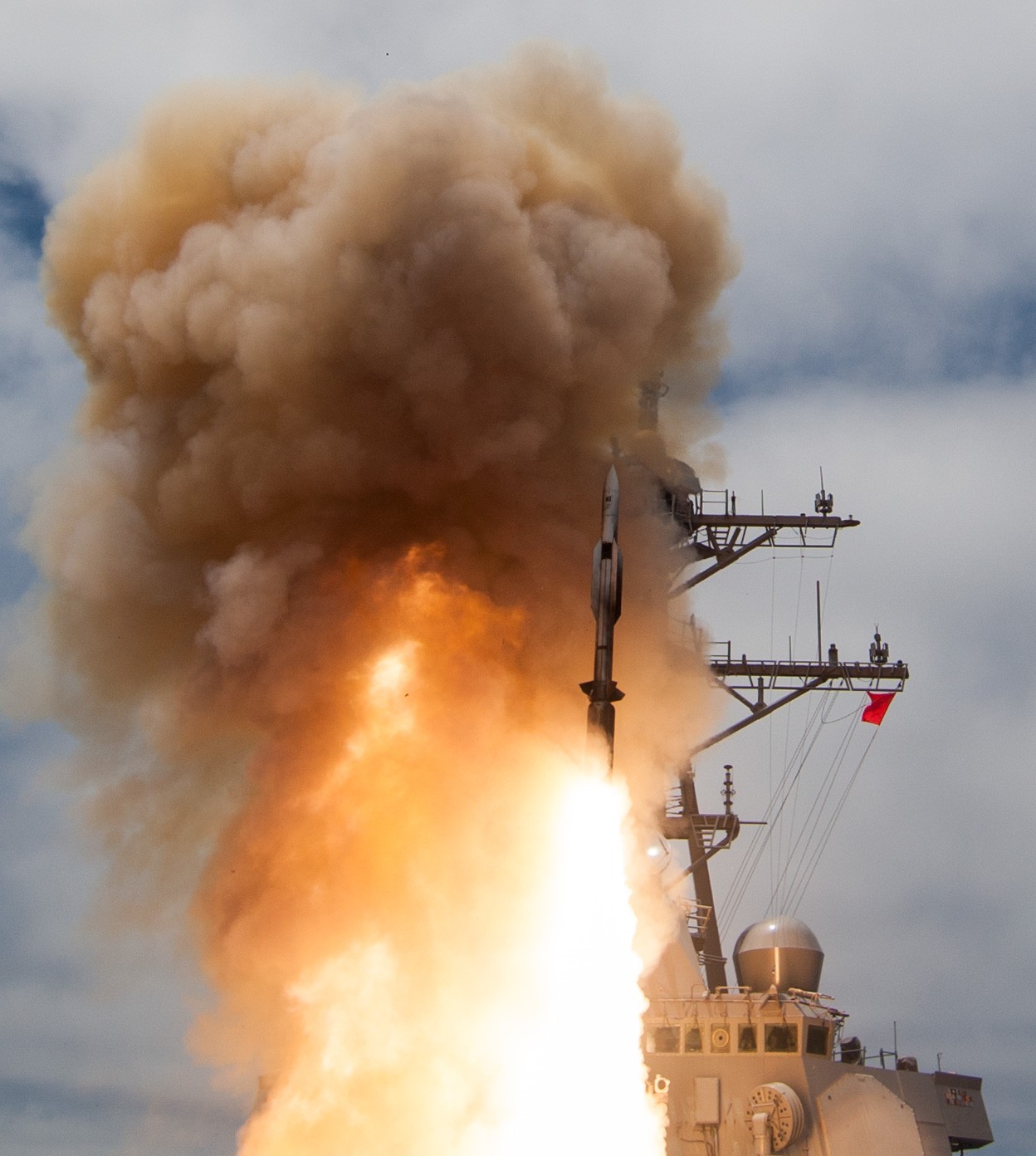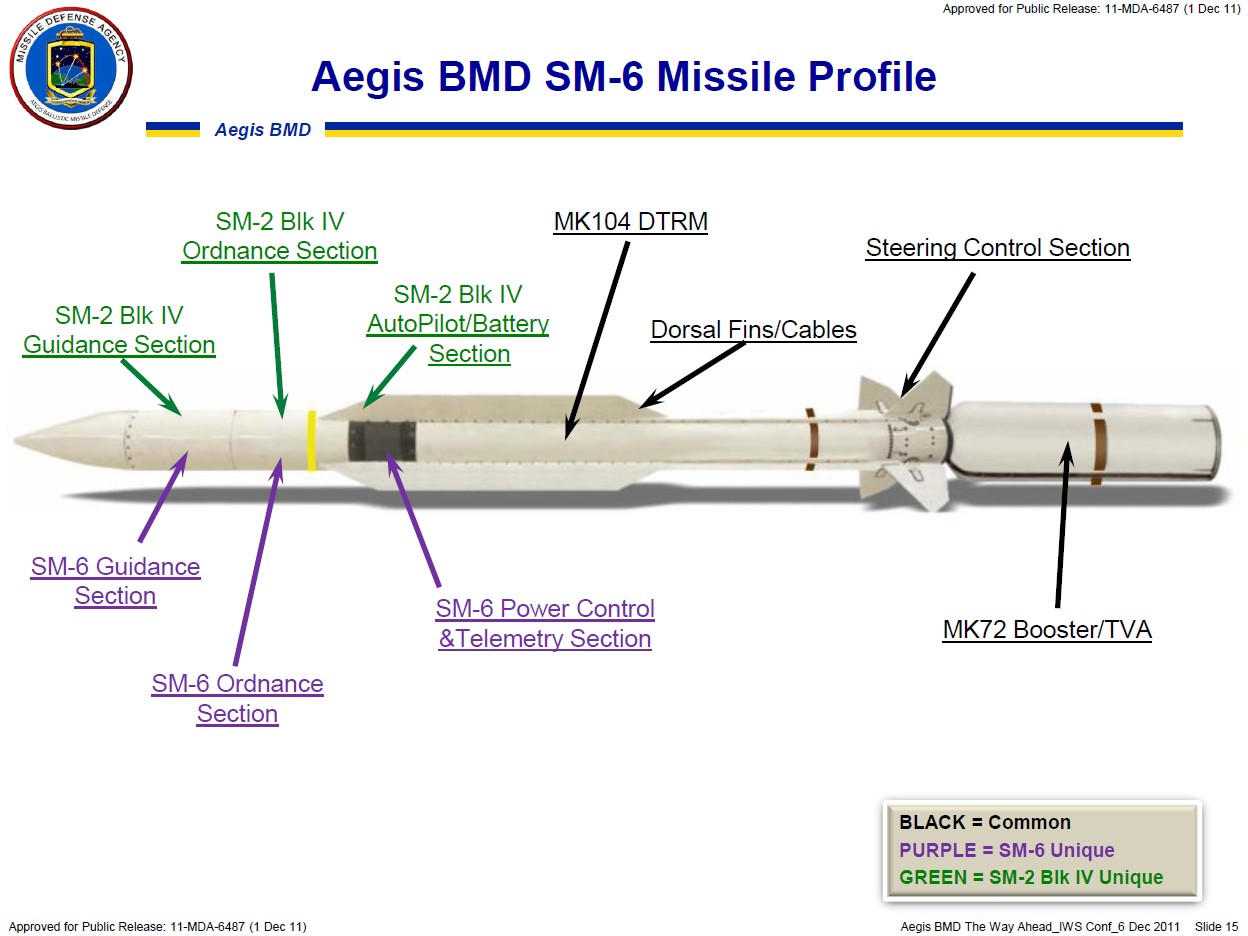|
|
|
HOME
|
US Navy -
ships
|
US Navy - air
units
|
USMC - air
units
|
International
Navies
|
Weapon Systems
|
Special Reports |
|
Surface Vessel Weapon System RIM-174 Standard ERAM (SM-6) SM-6 Standard Extended Range Active Missile |
 |
|
The RIM-174 Standard Extended Range Active Missile (ERAM), or
Standard Missile 6 (SM-6) is a missile in current production for the
United States Navy. It was designed for extended range anti-air
warfare (ER-AAW) purposes providing capability against fixed and
rotary-wing aircraft, unmanned aerial vehicles, and anti-ship cruise
missiles in flight, both over sea and land. The missile uses the
airframe of the earlier
SM-2ER Block IV (RIM-156A) missile, adding the active
radar homing seeker from the AIM-120C AMRAAM in place of the
semi-active seeker of the previous design. This will improve the
capability of the Standard missile against highly agile targets, and
targets beyond the effective range of the launching vessels' target
illumination radars. Initial operating capability was planned for
2013 and has been successfully achieved on November 27, 2013. The
SM-6 is not meant to replace the SM-2 series of missiles, alongside
which it will serve, but does give extended range and increased
firepower. Description: The Standard ERAM is a two-stage missile with a booster stage and a second stage. It is similar in appearance to the RIM-156A Standard missile. The radar seeker is an enlarged version adapted from the AIM-120C AMRAAM seeker (13.5 inches versus 7 inches). The missile may be employed in a number of modes: inertial guided to target with terminal acquisition using active radar seeker, semi-active radar homing all the way, or an over the horizon shot with Cooperative Engagement Capability. The missile is also capable of terminal ballistic missile defense as a supplement to the Standard Missile 3 (RIM-161). Unlike other missiles of the Standard family, the Standard ERAM can be periodically tested and certified without removal from the VLS cell. The SM-6 offers extended range over previous SM-2 series missiles, primarily being able to intercept very high altitude or sea-skimming anti-ship missiles; the missile is also capable of performing terminal phase ballistic missile defense. It can discriminate targets using its dual-mode seeker, with the semi-active seeker relying on a ship-based illuminator to highlight the target, and the active seeker having the missile itself send out an electromagnetic signal; the active seeker has the ability to detect a land-based cruise missile amid ground features, even from behind a mountain. The multi-mission SM-6 is engineered with the aerodynamics of an SM-2, the propulsion booster stack of the SM-3, and the front end configuration of the AMRAAM. The U.S. Navy is adding the Global Positioning System (GPS) to the SM-6 so it has the capability to strike stationary land targets if needed, but given its higher cost than other land attack weapons like the BGM-109 Tomahawk it would not likely be used as a primary option. History: Raytheon entered a contract in 2004 to develop this missile for the United States Navy, after the cancellation of the Standard missile two extended range block IVA (RIM-156B). Development started in 2005, followed by testing in 2007. The missile was officially designated RIM-174A in February 2008. Initial low rate production was authorized in 2009. Raytheon received a $93 million contract to begin production of the RIM-174A in September 2009. The first low-rate production missile was delivered in March 2011. SM-6 was approved for full-rate production in May 2013 and the first full-production missile will be delivered in April 2015. As of 2013 the program is scheduled to build 1200 missiles at a total cost of $6,167.8m, at a flyaway cost of $4.3m. On October 3, 2013 Raytheon was awarded a contract for "89 Standard Missile-6 Block I all up rounds, spares, containers and services" by the U.S. Navy. On November 27, 2013 Standard ERAM achieved IOC (Initial Operating Capability) when it was fielded on board USS Kidd (DDG-100). During exercises from 18-20 June 2014, USS John Paul Jones (DDG-53) fired four SM-6 missiles. One part of the exercise, designated NIFC-CA AS-02A, resulted in the longest surface-to-air engagement in naval history. The exact range of the intercept was not publicly released. On 14 August 2014, an SM-6 was test fired against a subsonic, low-altitude cruise missile target and successfully intercepted it over land. A key element of the test was to assess its ability to discern a slow-moving target among ground clutter. On 24 October 2014, Raytheon announced that two SM-6 missiles intercepted anti-ship and cruise missile targets during "engage on remote" scenarios. A low-altitude, short-range supersonic GQM-163A and a low-altitude, medium-range subsonic BQM-74E were shot down by SM-6s fired from a guided-missile cruiser using targeting information provided by a guided-missile destroyer. Advanced warning and cueing from other ships allows the missile's over-the-horizon capability to be more greatly utilized so a single ship is able defend a larger area. In May 2015, the SM-6 was moved from low-rate to full-rate production, significantly increasing production numbers and further reducing cost. On 28 July 2015, the Navy tested the modified SM-6 Dual I version to successfully intercept a ballistic missile target in the terminal phase, the last few seconds before it would impact; the Dual I upgrade adds a more powerful processor that runs more sophisticated targeting software to hit a warhead descending from the upper atmosphere at extreme speed. This adds to the fleet's missile defense capabilities by allowing it to intercept ballistic missiles that could not be hit by SM-3 missiles, which targets missiles in the midcourse phase. The Navy had used the SM-2 Block IV as a terminal missile interceptor, but the SM-6 combines missile defense with traditional cruise missile and aircraft interdiction in the same package. The SM-6 Dual I configuration is planned to enter service in 2016. source: wikipedia (2016) Weight: 3300 pounds (1500 kilograms) Lenght: 21 feet 6 inches (6,55 meters) Diameter: 21 inches (53 centimeters) max. Propulsion: two stage: Solid rocket booster, solid rocket booster/sustainer Operational Range: 150 NM (240 km) Ceiling: up to 110000 feet (33000 meters) Speed: Mach 3,5+ Users: US Navy + Australia, Japan, Republic of Korea |
|
images |
 RIM-174 was launched from USS John Paul Jones (DDG 53)  |
|
|
seaforces.org
|
Weapon Systems
start page
| |
